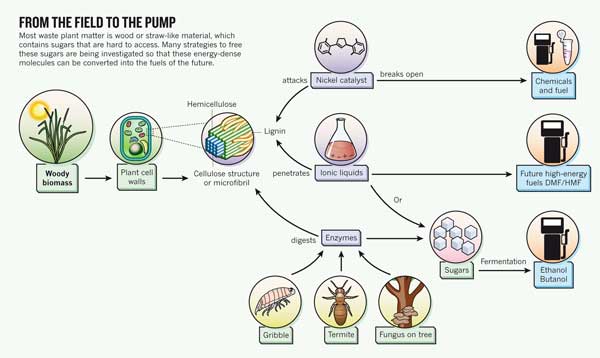Bioplastics: Difference between revisions
No edit summary |
No edit summary |
||
| Line 26: | Line 26: | ||
* [http://wiki.ultimaker.com/PLA ultimaker wiki] | * [http://wiki.ultimaker.com/PLA ultimaker wiki] | ||
* [http://http://bioplastics-cms.de/bioplastics/download/downloads.php bioplastics magazine] | * [http://http://bioplastics-cms.de/bioplastics/download/downloads.php bioplastics magazine] | ||
=Proposed OSE agroecological approach to bioplastic production= | |||
Bioplastics come in a variety of forms and will most likely be an important material in the post-scarcity economy. Bioplastics are polymers from a biological source including polyesters, olefins, and other organic chains that can be extruded into a variety of shapes. Plastics have been in production for hundreds of years from both organic sources and petroleum sources. An agroecological approach will utilize local feedstocks to produce refined subunits for polymerization and use life cycle analysis and appropriate technology to maximize efficiency on a small scale. An agroecological approach will build up polymers as opposed to petroleum based methods that start by breaking down materials. By starting with high purity substrates purification machinery can be minimized and hardware greatly reduced in size. | |||
This page is meant to organize the information being collected on bioplastic production and proposed project plans. | |||
Detailed background and status briefs of individual projects should be maintained on their own page. Information on the advantages and disadvantages of an "anabolic", organic, bioplastic | |||
=Plastics of interest= | |||
==Polyethylene== | |||
==Polylactic acid== | |||
==Polycellulose== | |||
=Feedstock= | |||
Sorghum is a feedstock of interest for bioplastic production due to its high productivity in producing sugars that can be fermented to either ethanol or lactic acid. The remaining bagasse contains cellulose which can be extracted after acid steam pretreatment as cellulose acetate. The remaining biomass can be burned for thermal energy or composted. Sorghum is a fairly resilient crop and can be planted on less desirable land. | |||
=Microorganisms= | |||
==Ethanol== | |||
==Lactic acid== | |||
=Hardware= | |||
==Fermentor== | |||
==Fluid Bed Reactor== | |||
Revision as of 15:23, 15 May 2012
Main > Materials > Bioplastics
Bioplastics are the perfect addition to an integrated farm and forestry operation. An effective open-source method of producing bioplastics will allow communities to be self-sufficient in the raw materials for many modern comforts. Bioplastics promise to replace the many useful products we currently extract from oil.
Combined with plastic extrusion and molding machines such as RepRap, bioplastics enable a local manufacturing process that starts with food waste or soil and creates computer and phone casings, car and machine parts, toys and tools, screws and sculptures.
Cellophane is reformulated cellulose (wood), produced via an acid and base dunk of sawdust. This may be used in glazing. Car bodies may be made; the original car bodies for Ford were soybean-derived bioplastics.
Polylactic acid can be made by fermenting starch.
Polyethelene can be fabricated from ethylene (which can be relatively easily produced from ethanol).
Mycelium can be placed in a mold with grain husks, wheat straw or any of a wide variety of other biomass (with different end product results) and be made into a variety of useful products, including a durable closed cell foam substitute. See: [1], [2] [3](these refer to the same product and company). Work need to be done open-sourcing this process - what mycelium are used? Where can we get spores? What can we make? We may be able to obtain some and identify it under a microscope (wary of nto infringing patents of course; maybe a similar but lower performing mycelium that is not patented could suit our purposes for building insulation etc.)
Where to get
- people of ultimachine.com made their way to natureworks LLC to get PLA (Polylactide), called ingeo (tm)
- makemendel.com offers PLA parts for Mendel since december 2011
- Shenzhen Esun Industrial Co. Ltd. (formerly Shenzhen Brightchina) produces PLA and PCL
- eastern bioplastics, biodegradable plastics from poultry feathers
- FKuR Kunststoff GmbH
- Freitec Kunststoffe GmbH
More readings
Proposed OSE agroecological approach to bioplastic production
Bioplastics come in a variety of forms and will most likely be an important material in the post-scarcity economy. Bioplastics are polymers from a biological source including polyesters, olefins, and other organic chains that can be extruded into a variety of shapes. Plastics have been in production for hundreds of years from both organic sources and petroleum sources. An agroecological approach will utilize local feedstocks to produce refined subunits for polymerization and use life cycle analysis and appropriate technology to maximize efficiency on a small scale. An agroecological approach will build up polymers as opposed to petroleum based methods that start by breaking down materials. By starting with high purity substrates purification machinery can be minimized and hardware greatly reduced in size.
This page is meant to organize the information being collected on bioplastic production and proposed project plans. Detailed background and status briefs of individual projects should be maintained on their own page. Information on the advantages and disadvantages of an "anabolic", organic, bioplastic
Plastics of interest
Polyethylene
Polylactic acid
Polycellulose
Feedstock
Sorghum is a feedstock of interest for bioplastic production due to its high productivity in producing sugars that can be fermented to either ethanol or lactic acid. The remaining bagasse contains cellulose which can be extracted after acid steam pretreatment as cellulose acetate. The remaining biomass can be burned for thermal energy or composted. Sorghum is a fairly resilient crop and can be planted on less desirable land.
